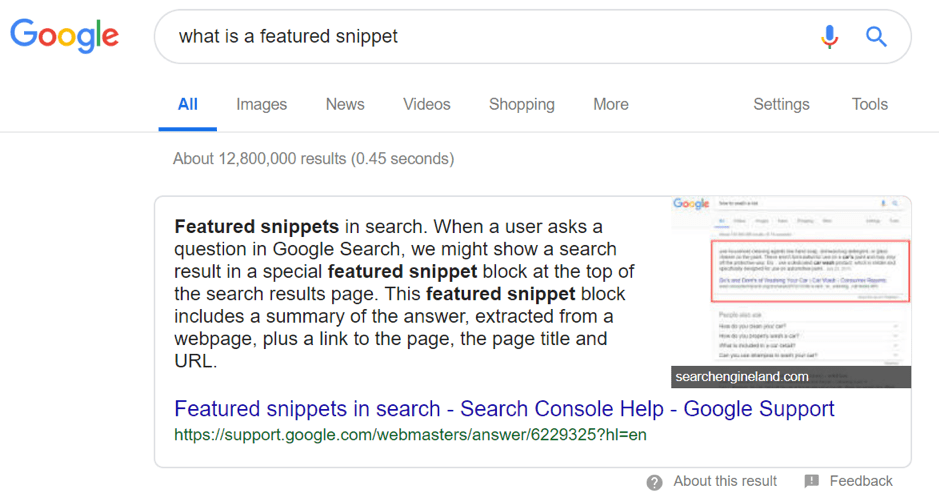- 0243394034
- info@centralcoastseo.com.au
- Google 1st Pages Guaranteed in Writing.
How to Get a Featured Snippet to Rank Position Zero in Google!

A strategic SERP plan that helps you get a ‘Featured Snippet’ can have huge implications for website traffic. Get that right and you’ll rank ‘Position Zero’ in Google search!
Search Engine Ranking Position (or Page) Explained
When you search for something online, Google determines which sites will appear at the top of a search from the expert SEO done on the website – rather than from the companies who offer the best product or service. (Though they may of course be one and the same).
In order to provide value for searchers, Google lists these websites in descending order. And naturally you’ll increase your site traffic if you can create a SERP plan to master your Google rankings. Because being good at what you do is only one piece of the puzzle. How well your website is SEO’d is the other. And no business can grow with mastering both.
How Do the SERPs Work?
Before devising an effective SERP plan that helps you get a ‘Featured Snippet’, it helps to know more about SERPs themselves.
SERP stands for Search Engine Ranking Position (or sometimes, ‘Page’). And when someone is first in Google search, they are SERP 1. When they’re tenth in Google they’re SERP 10, etc.
SERPs are always unique. If two users type two inquiries into the same search engine using the same keywords, they will get different results.
Google customizes results for users in order to give them the most useful results.
Each SERP is unique because of factors like a searcher’s location, browsing history, and more. Even if the two pages look the same at first glance, there will likely be small differences according to the different users.
In order to provide the best value to users, Google is always changing the way SERPs appear. It’s important to stay up to date on the latest algorithms and experiments Google is conducting, so you can modify your SERP plan accordingly.
Creating a Strategic SERP Plan
Ultimately, the key to a strategic SERP plan is providing searchers with valuable content (this blog being a case in point!).
If you can figure out the intent of searchers, and devise a way to provide them with what they’re looking for, Google will bump your site up on the page.
Due to the latest algorithms, sites can no longer “trick” Google by doing things like keyword-stuffing or using dodgy links or dodgy SEO companies out of India, the Philippines or Russia.
Additionally, longer, more informative content is now prioritised over short, less informative posts.
These changes mean that your SERP plan should be common sense: give searchers content they can use, instead of trying to use tricks and workarounds to fool Google.
Of course, it’s not all that straightforward. There are paid ads that appear at the top of the page for you to compete with, as well as other sites that are trying to do the same thing as you.
So how do you approach SERP in a way that will both please Google and beat the competition? One of the best ways is by getting a featured snippet.
Featured Snippets
You’ve probably already seen featured snippets on your own Google searches. These appear in a box at the top of the search results page. Featured snippets take a summary of the answer to the searcher’s query directly from the webpage.
Users will also see a link to the page, the page’s title and the URL along with the snippet. According to Google, “The summary is a snippet extracted programmatically from what a visitor sees on your web page.”
Of course, a user is likely to pay more attention to content with a featured snippet than to content without one. Results with featured snippets are at the top of the page, and they also provide users with a hint that this page will definitely have the information they want.
 How Do I Get a Featured Snippet?
How Do I Get a Featured Snippet?
To get your site at the top of the page with a snippet attached, use these simple steps.
- Figure out a question
You’ll want to start by finding a straightforward question that searchers in your market area are likely to ask. This question should be simple and clear, not complex or ambiguous.
- Provide an answer
Somewhere on your site, make sure that question is answered clearly and directly.
- Give value to users
It’s not enough to just answer the question. Your site should also give information beyond the simple answer, so that users will gain something from clicking through. Keep in mind that Google prioritizes longer content than it did before.
- Make the information easy to find
This essential information should be easy to find on your webpage, not buried somewhere behind lots of other posts.
Choosing the Right Questions
Getting a featured snippet is not easy, however. So don’t think it is. But by understanding the intent of your users (and answering the question) you can get them.
And four-step approach described above is do-able and (importantly) easy to repeat. So doon’t stick with answering one question. Research and find out several questions that might be asked about your product or service. Then work on creating content that answers each of those questions, in addition to providing helpful additional information in each post.
In order to target the right questions, long-tail keywords can become your best friend. Don’t just target general keywords: target the full question, including the “how to,” “how does,” or “what is” etc, that many users type in the Google’s search bar.
Narrowing down user queries in this way helps you on your way to getting a featured snippet. Not sure where to start? Type in a question that users might have about what you sell or do, into Google yourself. You’ll then see other, related inquiries that people have searched for pop up. These suggestions are invaluable, and are Google’s way of telling you what sorts of semantically related questions people are actually asking. All you have to do is answer them!
To take this a step further, try answerthepublic.com, which suggests possible questions based on a keyword using a cool visualization.
Someone Has to Get the Featured Snippets – Why Not You?
Ultimately, your chances of getting a featured snippet depend on a few key factors.
Do you accurately nail down and answer the right questions? A bit of research, as discussed above, can help ensure that you do.
Are you providing the best answers to those questions? The more clear, straightforward, and accurate your answer is, the more likely it will be the one that Google will choose to feature.
Finally, you must make sure that you are providing content that is genuinely useful. If you write 50 blog posts of 50 words each that all provide one answer to a commonly asked question, you won’t do well on the SERPs.
Users want to find longer content that is high quality and detailed, covering everything they might want to know that’s related to their question. And it’s also crucial that your content is engaging and entertaining.
It’s all about value. Provide users with valuable, interesting answers to their inquiries, and Google will reward you.
Of course, you don’t need to do SEO all on your own. So if you’re looking for help getting to the top of Google, contact Central Coast SEO & Web Design on (02) 4339 4034 today, and let us work out a detailed SEO strategy to take your business to the next level in 2020.


















